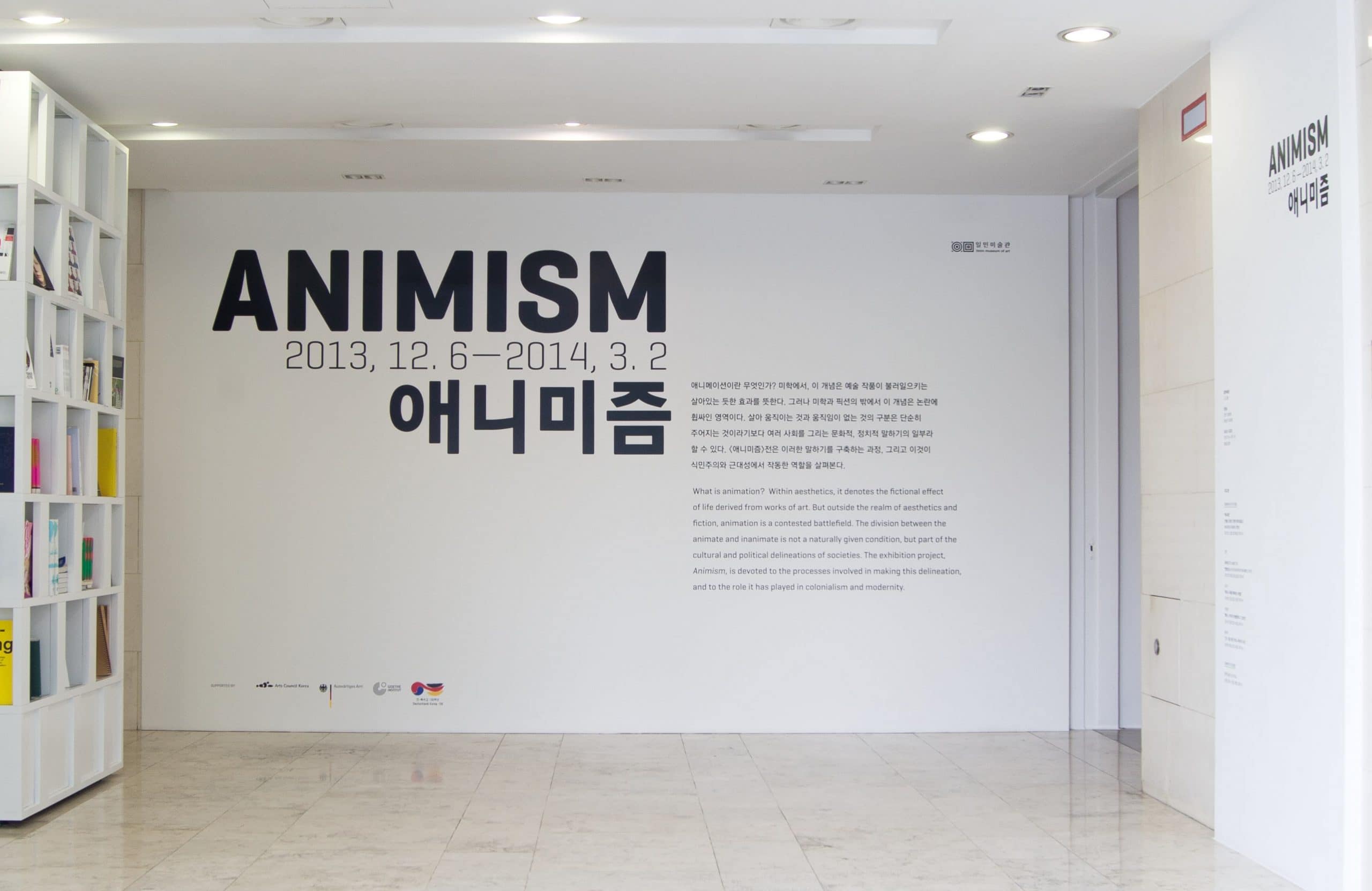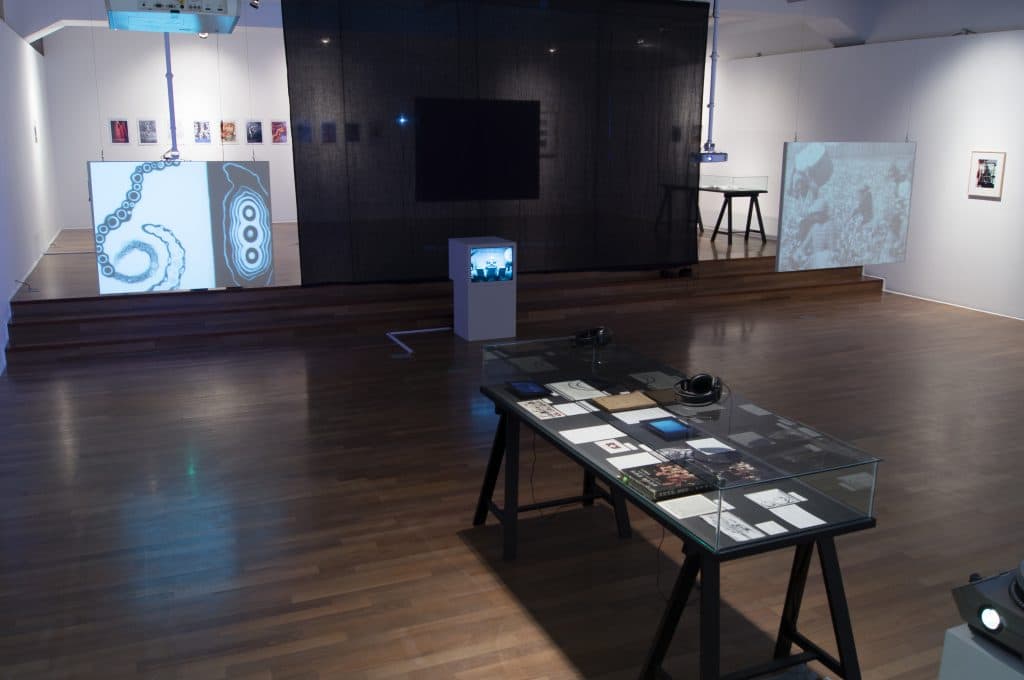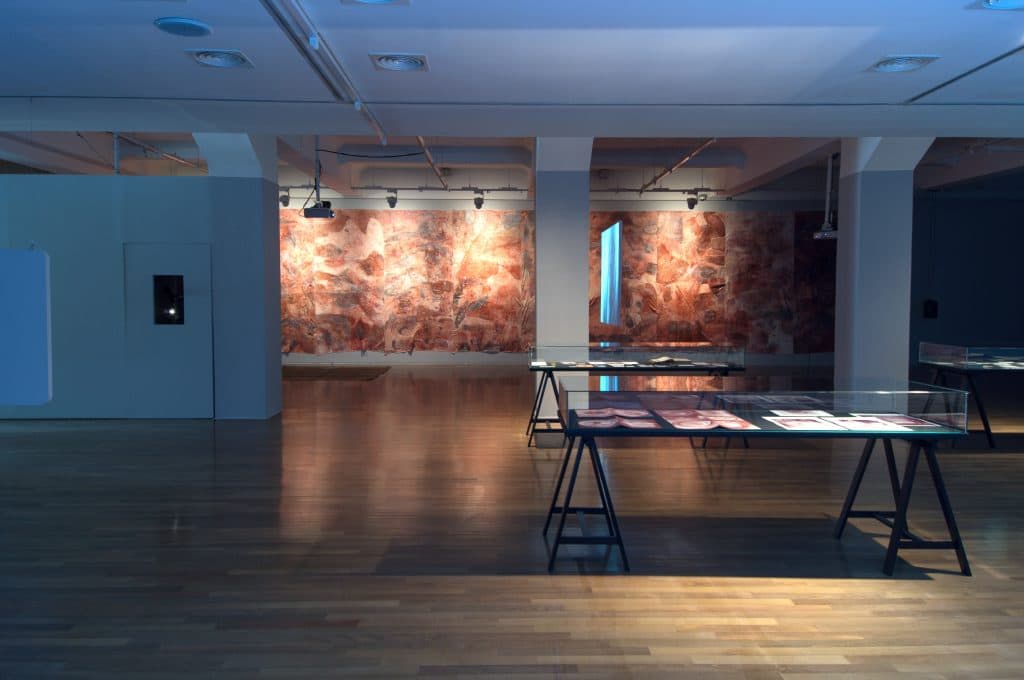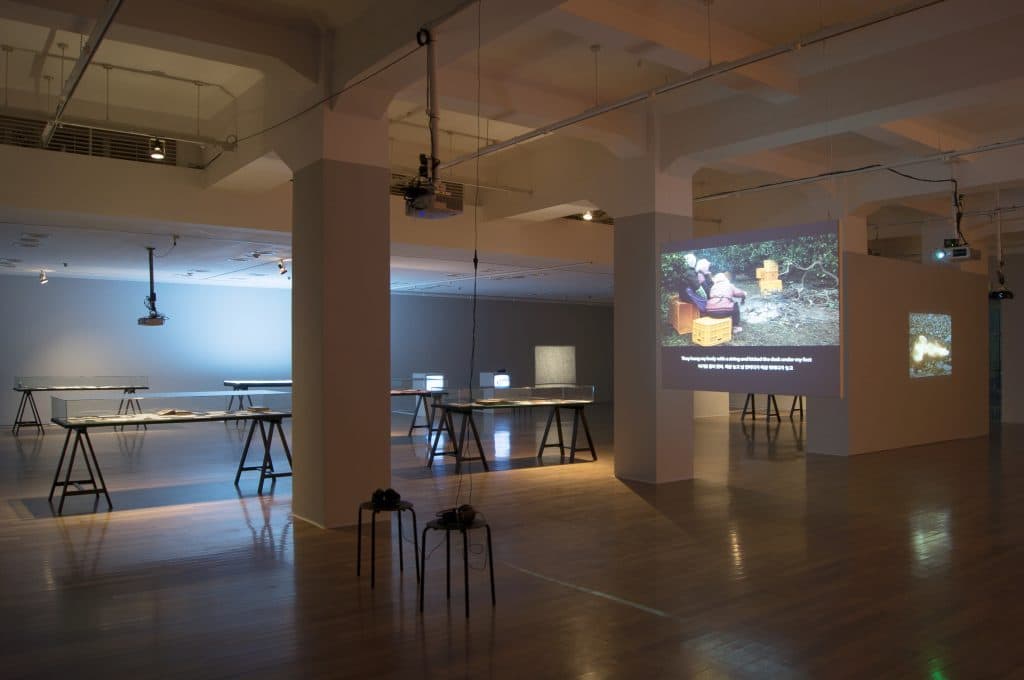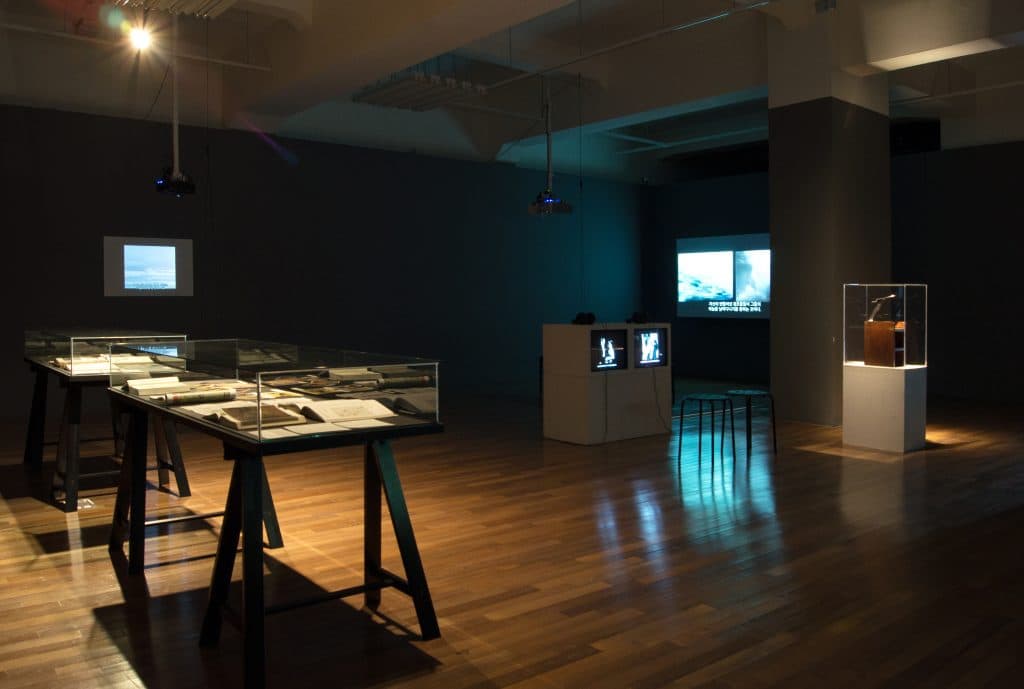«애니미즘» 전시의 출발점은 예술이나 만화영화와 같은 대중문화에서 이미 우리에게 친숙한 애니메이션이다. 예술에서 애니메이션은 특히 멈춰있는 어떤 것에 움직임을 가해 생명력을 불러일으키는 효과로 흔하게 사용되고 있지만, 조각이나 특정 회화와 같은 미술 작품들이 관객의 시선을 되살아나게 하는 효과 또한 존재한다.
그러나 미술의 여러 기법 중 하나로 인식되는 애니메이션은 기법에만 국한되지 않는 역사적 논쟁의 주제이다. 살아 있다고 인지하는 것은 무엇인가? 미술이라는 범위 밖에서 이러한 질문을 던진다면, 질문 자체를 더 구체적으로 설명하기 위한 구별짓기를 요하는 또 다른 질문들을 여지 없이 불러일으킬 것이다. 단지 움직임을 가하는 것은 개별적인 생명과 동등한 개념으로 인식되지 않으며, 이 사실은 의심할 여지가 없어 보인다. 그러나 그것을 구분하는 경계선은 어디 있는가? 영혼이나 생명, 움직이는 힘을 가진 것은 무엇인가? 생물인 것과 생물이 아닌 것 사이의, 혹은 순수한 주체와 단순한 객체 사이의 경계는 결코 자연적으로 주어진 것이 아니다. 이는 각기 다른 문화에서 이 경계가 매우 상이한 방식으로 인식되고 상상된다는 단순한 사실로 알 수 있다. 따라서 “올바른” 구분이라는 것에 관해 궁극적으로 “객관적인” 규정이란 것은 없다. 하지만 이 경계선은 “순전히” 주관적인 문제도 아니다. 결국, 이 경계선이 자연과 인간의 물질적 관계에 중요한 만큼, 특정 사회에 존재하는 유생물들의 사회정치적 상태에 대한 문제에서도 중요하다. 이러한 경계선 자체를 조직적인 지식 시스템 및 실천들과 함께 검토하는 것이 가능할 것인가? «애니미즘» 기획은 가상의 구분이 증후적으로 문화를 반영한다는 전제, 그리고 재현, 미학적 과정, 미디어 이미지는 이러한 경계선을 구축하고, 반영하고 가로지른다는 전제로부터 시작한다. 결과적으로 이 전시는 어떻게 이러한 경계가 미학적 주관화와 객관화 과정에 반영되어 있는지를 탐구하며, 이러한 미학적 과정들을 식민지적 근대성이라는 견고한 사회정치적 맥락에 놓고자 한다.
애니미즘에서는 근대 서구적 관점(이 관점의 이원론적 개념은 주체와 객체라는 범주의 분리를 전제로 한다)에 대한 가장 급진적인 반(反)원형이 발견된다. 애니미즘은 자연과 문화의 구분이 거의 없는 사고방식, 물체와 자연, 또는 전 우주가 살아 있고 유사 주체화된 것으로 인식하는 세계관에 해당한다. 19세기 말, 근대적 세계관은 식민주의와 과학의 발전이라는 믿음의 정점에서 전근대적인 타자의 이미지로부터 자기 확신을 찾고자 했다. 애니미즘은 타자라는 개념의 현현(顯現)이 되었다. 애니미즘은 “탈신비화된” 객관화, 구체화된 근대성의 세계에 대한 반(反)원형이다. 근대적 관점에서 본 애니미즘은 앞에서 언급한 경계들이 잘못 이해되거나-낭만적이고 유토피아적인 방식으로- 그 경계를 탈피한 마술적 변형의 세계를 대표한다.
애니미즘의 문화가 상당히 실제적임에도 불구하고 (오늘날 전세계 인구의 40% 정도가 소위 “애니미즘적 믿음”을 가지고 있다) 서구 근대성의 역사에서 이를 설명하는 것은 쉽지 않았다. 근대 지식과 그 과학적인 원칙들이 담보하고 있는 “자연”과 “문화”, “주체”와 “객체”의 구성이라는 기본적인 가정에서 시작한다면, 애니미즘을 “신념”이나 “순수한 믿음”으로 규정하는 것 이상의 선택은 불가능하며, 그렇게 된다면 사물들의 객관적인 현실을 파악하는 데 실패하고 종국엔 “심리적인 매커니즘”으로만 애니미즘을 설명해버리게 된다. 근대적 지식으로 봤을 때 애니미스트는 “객관적 지식”에 도달하지 못한 이들로서 내적 심리적 현실과 외부 세계의 사실을 “잘못” 혼동한 이들이다. 이러한 시각은 애니미스트 문화가 기술을 수단 삼아 환경을 정복하는 것을 등한시한다는 사실을 지적한 근대의 발언들 덕에 더 지지받았다. 하지만 애니미즘을 바라보는 근대적 시각은 철저히 투사에 불과하다. 애니미스트가 현실에 대해 말하는 것을 현실이 아니라 자신들의 신념에 기반한 의심할 여지없는 가정, 예를 들어 “바깥의” 세상은 오로지 물질적 법칙을 따르는 중립적인 무생물의 것으로 이뤄져 있다는 식의 렌즈를 통해서만 평가하기 때문이다.
애니미즘을 전시의 주제로 선택한 결정적인 이유는 이 개념이 서구 근대성이라는 개념의 실제적인 제약이 되는 동시에, 근대 지성계의 과학적 원리의 영역에서 지식의 인식과 그 질서에 깊이 새겨진 근대적 현실 원칙에 대한 도발이기 때문이다. 애니미즘의 관습들은 기껏해야 ”문화”라는 범주 아래 인식되었고, 그것도 우주와 세계의 실제적인 특질에 발언하고자 하지 않는 경우에 한해서였다.
결론적으로 «애니미즘» 은 애니미즘에 대한 문화 인류학적 유물들을 진열장에 담아 전시하며 다른 문화가 저 자신만의 방식으로 살아있다고 주장하는 류의 전시가 아니다. 애니미즘을 전근대적인 타자로 보고 단순히 생명이 없는 물체에 영혼을 부여하는 의미로 잘못 믿고 있는 서구적/근대적 사고는 사실 그 자체로 이 근대성의 근본적인 가정들을 징후적으로 보여준다. 이에 반해 이 전시의 의도는 서구 근대성의 뿌리에 자리 잡은 근본적 가정들을 비출 수 있는 거울로서 애니미즘 안에 존재하는 용어와 개념을 살펴보고, 이것이 경계의 산물이며 경계를 만들어 내는 방식, 기술, 신화들의 산물임을 인식하고자 한다. «애니미즘» 기획은 애니미즘에 대한 제한적 이해와 그 표현에 대한 근대적 상상들을 반성하고, 또 그에 대한 식민주의적 사고방식에서 탈피할 필요성을 제기한다.
참여작가
구동희, 길초실, 김상돈, 나타샤 사드르 하기기안, 다리아 마틴, 디엑 슈미트, 레온 페라리, 렌 라이, 마르셀 브로타에스, 박찬경, 박호상, 빈센트 모니켄덤, 수잔 슈플리, 아나 멘디에타, 안젤라 멜리토풀로스 & 마우리치오 라자라토, 알 클라, 애덤 아비카이넨, 에르하르트 슈트펠츠 & 에흘러 보스, 에릭 슈타인브레허, 여반트 기니키안 & 안젤라 리치 루치, 오토봉 낭가, 요아킴 쾨스터, 월트 디즈니, 이동엽, 임흥순, 자크라왈 닐탐롱, 장 팽레베, 지미 더햄, 칸디다 회퍼, 켄 제이콥스, 쿠사마 야요이, 크리스 마커 & 알랭 레네, 톰 홀러트, 파울로 타바레스, 하룬 파로키, 하인츠 쇼트, 한스 리히터
주최
일민미술관
장소
일민미술관 1, 2, 3 전시실
전시기획
안젤름 프랑케
전시 및 리서치 협업
김현진
후원
주한독일문화원, 주한독일대사관, 한국문화예술위원회
The exhibition ANIMISM begins with that which we are all familiar with from art and the products of mass cultureㅡthe cartoon for exampleㅡas animation. Within art, animation is a common effect used to evoke life and vitality, in particular through movement, although it is also present when art worksㅡsculptures or specific picturesㅡappear to return the gaze of the viewer. However, what we accept as an effect in art is a subject of historical contention beyond its confines. What do we perceive as being alive? When we ask this question outside the field of art it invariably raises questions which call on us to provide further distinctions for the purpose of clarification. The mere effect of vitality is not to be equated with independent life, this appears beyond doubt. But where is the dividing line? What possesses a soul, life, and the power to act? That the border between animate and inanimate matter, or between pure subjects and mere objects, is in no sense a natural given is demonstrated by the simple fact that in different cultures this border is perceived and conceived of in highly different ways. Consequently, there can never be an ultimately “objective” designation of the “correct” division. However, the dividing line is not a “purely” subjective matter eitherㅡafter all, it is just as important for the organization of our material relations to nature as for the question of the social and political status of living beings in a specific society. Is it possible to examine this dividing line itself, together with the organizing knowledge systems and practices? The project ANIMISM proceeds from the premise that imaginary demarcations symptomatically reflect cultures, that representations, aesthetic processes and media images consolidate, reflect and transgress these dividing lines. Consequently, the exhibition explores how this border is reflected in aesthetic subjectification and objectification processes, and attempts to situate these aesthetic processes in the concrete socio-political contexts of colonial modernity.
The most radical antitype to the modern Western world view (whose dualistic conception is built on a categorical separation of subject and object) is to be found in animism. Animism is applied to those world views in which there is seemingly no division between nature and culture, in which objects, nature, or the entire cosmos, are perceived of as being alive, and thus quasi subjectified. At the end of the 19th century, at the zenith of colonialism and the belief in scientific progress, the modern world view attempted to find self-confirmation in its image of the pre-modern other. Animism became the exemplary manifestation of this idea of the other. Animism is an antitype to the “disenchanted,” objectified, reified world of modernity. From the modern perspective, it stands for a world of magic transformations in which the borders are supposedly misconceived, orㅡin a romantic-utopian turnㅡovercome.
As real as animistic cultures are on the one handㅡaround 40 percent of the world’s population today have so-called “animistic beliefs”ㅡthey proved hard to explain for the tradition of Western modernity. If we start from the basic assumptions as to what constitutes “nature” and “culture,” “subject” and “object” that underwrite modern knowledge and its scientific disciplines, then it appears that we have no other option than to characterize animism as a “faith” or “mere belief”, which fails to grasp the objective reality of things, explaining it in the last instance as a “psychological mechanism.” Animists, for modern knowledge, were people who failed to arrive at “objective knowledge”, becomes they “erroneously” confused their inner psychological reality with the facts of the outer world. And this view seemed to be supported in the eyes of the modern voices by the fact that animist cultures are far less busy in conquering their environments by means of technology. But the modern view of animism is a projection throughout: It measures what animist people say about reality not as reality, but only through the lens of unquestioned assumptions on which their own knowledge is built, for instance, the assumption that the world “out there” basically consists of indifferent, inanimate matter that follows only material laws.
We have taken animism as our theme precisely because it represents a real limit to the conception of Western modernity, a provocation to the modern principle of reality which has become deeply inscribed in perception and the order of knowledge in our division of scientific disciplines in the modern academy. At best animistic practices are recognized under the category of “culture,” but only as long as they don’t raise any claims to making statements about the actual character of the cosmos and the world.
Consequently ANIMISM is not an exhibition about animism which exhibits ethnographic objects in display cases which other cultures claim to be animate in one or another way. The Western-modern idea of animism as the pre-modern other that falsely believes in the ensoulment of objects which are in fact inanimate is itself a symptomatic expression of this modernity’s basic assumptions. In contrast, the intention is to view the term and the idea inscribed within it as a mirror which can be used to examine these basic assumptions at the root of Western modernity, and thus recognize them as the product of demarcations, of actual border-making practices, technologies and mythologies. The project ANIMISM raises the necessity of a revision and decolonization of the modern imagination of which it the concept is an expression and symptom.
Artists
Adam Avikainen, Al Clah, Ana Mendieta, Angela Melitopoulos & Maurizio Lazzarato, Candida Höfer, Chosil Kil, Chris Marker & Alain Resnais, Daria Martin, Dierk Schmidt, Donghee Koo, Dongyeop Lee, Erhard Schüttpelz & Ehler Voss, Erik Steinbrecher, Hans Richter, Harun Farocki, Heinz Schott, Heunsoon Im, Hosang Park, Jakrawal Nilthamrong, Jean Painlevé, Jimmie Durham, Joachim Koester, Ken Jacobs, Len Lye, León Ferrari, Marcel Broodthaers, Natascha Sadr Haghighian, Otobong Nkanga, Park Chan-kyong, Paulo Tavares, Sangdon Kim, Susan Schüppli, Tom Holert, Vincent Monnikendam, Walt Disney, Yayoi Kusama, Yervant Gianikian & Angela Ricci Lucchi
Venue
Gallery 1, 2, 3
Organized by
Ilmin Museum of Art
Curated by
Anselm Franke
In collaboration with
Hyunjin Kim
Supported by
Goethe Institut
Auswärtiges Amt
Arts Council Korea

